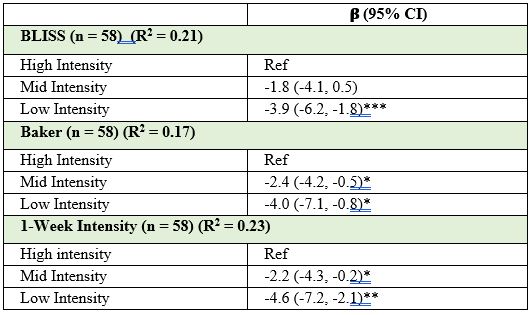Breastfeeding/Human Milk
Session: Breastfeeding/Human Milk 1: Breastfeeding
473 - Comparing Instruments for Measuring Breastfeeding Intensity and Duration
Sunday, May 5, 2024
3:30 PM - 6:00 PM ET
Poster Number: 473
Publication Number: 473.1974
Publication Number: 473.1974
.jpg)
Isabella J. Lawandy, MS, MPH (she/her/hers)
Project Manager
Brigham and Women's Hospital
Somerville, Massachusetts, United States
Presenting Author(s)
Background: Current breastfeeding (BF) outcome indices have had limited external validation against maternal and child health outcomes. After a literature review, three measures have been proposed (BLISS scale, Baker scale, and 1-Week Intensity score), but the extent to which they are associated with clinically important maternal and child health outcomes is unknown.
Objective: To compare and verify the external validity of three BF intensity scores for predicting postpartum (PP) weight loss and infant daily human milk (HM) intake.
Design/Methods: This analysis included 95 mothers with high breastfeeding intention, and their infants, enrolled in an ongoing lactation study in Boston, MA. At 6 weeks PP, breastfeeding mothers reported on their (1) Breastfeeding intensity and duration via the 2-month Infant Feeding Practices II Survey (IFPS-II) and a BF questionnaire, and (2) Infant’s estimated daily HM intake via a 24-hr feeding log which included pre- and post-breastfeeding weights and volume of any pumped HM and formula consumed. The exposures were the following three BF indices: (1) The BLISS scale scoring was adapted for our 6-week time point using responses from the IFPS-II regarding how often formula was given to the infant, with a maximum of 6 points for no formula intake. (2) The Baker scale was calculated by awarding 1 point/week of exclusive BF and 0.5 point/week of partial BF. (3) The 1-Week Intensity score was calculated as the number of HM feedings/total number of feedings per day in the last 7 days and reported as a %. The outcomes were 6 weeks PP weight loss (derived from medical record) and % of HM intake in 24 hr. We used linear regression to examine associations of individual BF indices with the outcomes and compared R2 values to determine which BF intensity index best explained variation in the outcomes.
Results: All three scores were highly correlated (Table 1). We found that higher scores on each of the instruments at 6 weeks PP (vs. lower scores), indicating higher BF intensity, were significantly associated with more PP weight loss at 6 weeks and a greater % of daily HM intake by infants at 6-weeks, (Table 2, Table 3). The 1-Week Intensity score (R2 = 0.23) was the strongest predictor of maternal weight loss, while the modified BLISS scale was the strongest predictor of infant daily HM consumption (R2 = 0.80).
Conclusion(s): Different BF indices may reflect different aspects of the intensity of BF, and as such may have differential associations with BF-related outcomes. This should be considered when designing BF research and methodology.
.jpg)

.jpg)
